ABPosauner
Oud Admirer

Posts: 3
Registered: 11-10-2019
Member Is Offline
|
|
I have no idea what I'm doing, please help!
I have some questions I was helping you could help me with or might be able to guide me in the right direction. I am an elementary music teacher at a
K-8 school located near Sacramento. Recently a parent asked if I would be interested in receiving an oud so I could share the instrument and the music
with my students. Her husband, who is Turkish, and had a relative bring the instrument back from Syria and wanted to learn to play but had never
gotten around to it.
Since I have a background in Kodaly music education I would love to learn some folk music from that region of the middle east and how to play the oud
so I could share it with my students. In order to do so I have many questions first.
What style of oud is it? I don't want to assume it's Syrian just because someone said they brought it back from Syria.
How should I tune it? Currently it has 9 strings on it, but there are enough holes in the bridge for 12. Unfortunately it looks like someone altered
the nut so that it can only have 10 strings at the most. It has 11 tuning pegs and an empty hole for a 12th in the peg box. Most of the ouds I have
seen have 11 strings in 6 courses.
I measured the string length from the nut to the bridge and it is 60cm. It came with two plectrums that appear to be the right style and I have a set
of replacement strings that I ordered on Amazon. But before I proceeded to replace the strings I wanted to get advice from an expert before I possibly
did anything wrong. I feel pretty confident in the actual process of changing the strings and tuning it up because I have changed many strings on
violins, classical guitars, ukuleles, mandolins, dulcimers, etc.
I would appreciate any help you could give me.
EDIT: Sorry for the trouble with pictures. I haven't posted to a bulletin board in a while so I've forgotten how to share photos and used BB code. I
also apologize for the giant photos. But at least they should be visible now.
Can anyone translate what the label says for me? I'd like to relay the information to the owner of the oud.
In this last photo you can see where the side of the bowl is detaching from the face. Should I be concerned about this? Is there any preventative
maintenance I should do?
|
|
|
Jody Stecher
Oud Junkie
    
Posts: 1378
Registered: 11-5-2011
Location: California
Member Is Offline
|
|
I can get you started by telling you a few things
1) from the one and only visible photo this appears to be strung for a left handed player.
2) all I can see of the oud is the sound hole and label. What I see, combined with the 60cm scale is that this is some kind of Arabic oud, designed
for playing some kind of Arabic music.
3) there are several traditional patterns of stringing an oud (which string goes to which peg). None of them resemble the pattern on violins,
guitars, etc. You can find out everything you need to know by using the search function on this website.
4) the right hand technique for oud is not like other instruments. Again, use the search function. Any other plectrum grip will result in insipid
sound.
This is one of the mysteries of the oud ! :-)
5) many ouds have 5 double courses. Up to the middle of the 20th century this was normal .
6) Your links are not clickable. Copying and pasting produces no results. Provide access to the photos and you'll likely get some useful responses
from some of the forum members here.
|
|
|
Brian Prunka
Oud Junkie
    
Posts: 2949
Registered: 1-30-2004
Location: Brooklyn, NY
Member Is Offline
Mood: Stringish
|
|
Jody's advice is excellent. Most of your questions have been answered many times in the forum, please use the search function and read what people
have had to say in the past. There are a lot of helpful tutorials on youtube, or at least videos of people playing that should help you figure some
things out.
The oud is by Salmeen, in Kuwait. It's unclear to me if they are the actual manufacturers or just a store . . . either way, it appears to be a
mid-grade factory-produced instrument. The pegs looks pretty decent, which is a huge plus in this level of oud.
5 double courses is fine, this is the old style.
This would traditionally be G A d g c' or F A d g c'.
You can add a low C course (single string) or a high f'f' course (double strings).
You'd have to have a nut cut for whatever you ended up using, but for now it's not necessary to change it.
I'm going to fix your photos, but please delete your gigantic ones so the thread is more navigable.
|
|
|
Brian Prunka
Oud Junkie
    
Posts: 2949
Registered: 1-30-2004
Location: Brooklyn, NY
Member Is Offline
Mood: Stringish
|
|
Resized photos:
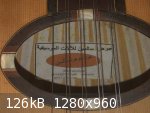
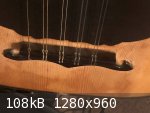
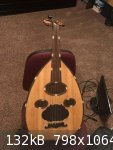
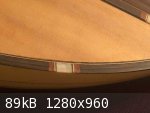
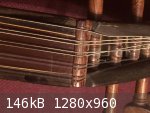
|
|
|
Brian Prunka
Oud Junkie
    
Posts: 2949
Registered: 1-30-2004
Location: Brooklyn, NY
Member Is Offline
Mood: Stringish
|
|
The crack is significant, I would get that repaired if you can.
It's worth checking at that point if there seem to be any other internal issues.
Viken Najarian is a good luthier who can fix issues, he was located in Anaheim the last I checked. He is probably the nearest person to you who works
on ouds. He could also cut a new nut if you like (it would be worth upgrading to a bone or synthetic nut in my opinion—wood is a poor material for
a nut).
The bridge appears to possibly have come off and been reglued at some point. That's not necessarily a problem—it happens more regularly than it
should due to the use of poor-quality glues sometimes. Often the repair is much strong than the original glue job.
Seems like a decent oud overall!
|
|
|
Jody Stecher
Oud Junkie
    
Posts: 1378
Registered: 11-5-2011
Location: California
Member Is Offline
|
|
Thanks for posting the photos, Brian.
Now that I see the other photos I see I was deceived by light reflection. This oud is strung for right hand players.
Forum member Gary Haggerty is on the East Bay side of San Francisco and does splendid repair. He recently made a stunner out of a wrecked and flithy
oud I got at a Goodwill shop in Sacramento. It sounds great, looks great.
|
|
|
ABPosauner
Oud Admirer

Posts: 3
Registered: 11-10-2019
Member Is Offline
|
|
Thanks for the help everyone and sorry again for the technical problems.
One of the questions I had that didn't get answered was what style of oud is it? Turkish, Arabic, Syrian, etc.? Since I don't know what style it is I
was having trouble looking up which tuning to use.
Since it's not my instrument I don't want to put money into having a new nut made. I'll just play it with 5 courses. Although I will advise the owner
about getting it repaired.
Next, I'll need to start looking up songs to learn. I've already been reading about and watching videos of the various maqqam's (hope I spelled that
right).
|
|
|
Brian Prunka
Oud Junkie
    
Posts: 2949
Registered: 1-30-2004
Location: Brooklyn, NY
Member Is Offline
Mood: Stringish
|
|
I did answer your question, it's Kuwaiti.
Kuwait is an Arab country (as is Syria).
I also told you what tunings would be appropriate in my previous response.
There are no major differences between ouds from Arab countries. While there is something of a "Syrian" style vs. "Egyptian" vs. "Khaliji", etc.
these are minor differences and they are all suitable for any Arabic style. The one exception is the "Bashir" style with a floating bridge, which
necessitates higher tension strings and usually uses a higher tuning. While this style originates in Iraq, it is not inherently related to Iraqi
music; nonetheless, this is often referred to as "Iraqi" style.
|
|
|
ABPosauner
Oud Admirer

Posts: 3
Registered: 11-10-2019
Member Is Offline
|
|
I misunderstood you. I wasn't assuming that when you said Kuwait that was only where it was purchased, not that it was possible to be the style. My
understanding of the styles comes from looking at sights like arabinstruments.com. I don't think they list Kuwait as one of the styles they carry.
I have a couple more follow up questions.
The risha that were included with the oud are extremely flexible. Is that a necessity or would it be okay to use a slightly thicker one? When I play
guitar I use Fender mediums so that's what feels comfortable to me. I do realize that it's going to be way different on the oud. I guess my big
complaint is I feel like I don't have much control and the risha just flops around.
Is there a reason to go with a low F versus the low G on the 5th course? Obviously tuning to the low F would give me an extra note.
Since the owner of the oud is from Syria I was thinking I should start with Syrian music. Do you have any simple favorites to start with?
|
|
|
NafQan
Oud Admirer

Posts: 9
Registered: 11-21-2019
Location: Syria
Member Is Offline
|
|
It is nice to see your interest in this instrument. I felt the same way like you when I got my first Oud. The Rosettes style is Iraqi, but the strings
are attached to a fixed bridge.
I hope that you will enjoy playing it and if you have any question that you do not hesitate to ask.
Regarding how to tune it and as you only have 5 courses of strings, try the following for strings from up to down.
G2, A2, D3, G3, D4.
As for notes, here is a song by Rahbani brothers, Nassem Alina Alhawa, the breeze of love came to us. For Turkish songs, check Uskudara. You can find its notes on musescore here
|
|
|
Brian Prunka
Oud Junkie
    
Posts: 2949
Registered: 1-30-2004
Location: Brooklyn, NY
Member Is Offline
Mood: Stringish
|
|
Quote: Originally posted by ABPosauner  | I misunderstood you. I wasn't assuming that when you said Kuwait that was only where it was purchased, not that it was possible to be the style. My
understanding of the styles comes from looking at sights like arabinstruments.com. I don't think they list Kuwait as one of the styles they carry.
|
Don't worry about the "styles" of oud. There are only three primary styles:
Turkish
Classic Arabic
Floating Bridge Arabic (aka "Iraqi" or "Bashir" style)
That's it. There are classic Arabic ouds from Kuwait, Yemen, Egypt Syria, Iraq Palestine, Lebanon, Syria, Tunia, Morocco . . . they have some minor
differences but they are not significant. Even a lot of Arabic musicians are using Turkish ouds these days.
I've seen Khaliji (gulf) musicians using Egyptian, Syrian and Turkish ouds. I've seen Syrians using Egyptian ouds, and Palestinians using Iraqi ouds.
It doesn't really matter.
You have an Arabic oud. You can use it appropriately for any Arab music. Much of the most popular Arabic music is Syrian, Egyptian and Lebanese, but
of course there is a lot more out there. Iraqi repertoire is distinctive, as is Yemeni and other Gulf styles. Tunisia has its own classical
repertoire, etc.
| Quote: |
I have a couple more follow up questions.
The risha that were included with the oud are extremely flexible. Is that a necessity or would it be okay to use a slightly thicker one? When I play
guitar I use Fender mediums so that's what feels comfortable to me. I do realize that it's going to be way different on the oud. I guess my big
complaint is I feel like I don't have much control and the risha just flops around.
|
Oud risha is not similar to guitar picking.
It's better as a beginner to use a somewhat softer pick to learn control. If your risha flops around it's because you are not holding it correctly
and/or your hand/wrist/arm motion is off.
I recommend the standard Pyramid "Pro" risha for beginning players. It is an appropriate flexibility for learning, and it's around .7mm, which is in
the same ballpark as a fender medium. It's possible the rishas you have are too soft—if the ones you have are lighter than that, it's worth
upgrading.
| Quote: |
Is there a reason to go with a low F versus the low G on the 5th course? Obviously tuning to the low F would give me an extra note.
|
The G simplifies things, as the fingerings will be the same as the other g course and it gives you the open G, which is a pretty common note. The F
gives you a slightly larger range (three extra notes: F F1/2# and F#) but is a little trickier. Most oud sets are compromises on that string so you
can change the tuning to either if you want.
| Quote: |
Since the owner of the oud is from Syria I was thinking I should start with Syrian music. Do you have any simple favorites to start with?
|
For Syrian repertoire, I'd recommend checking out Sabah Fakhri, he sings a lot of short songs with melodies that are easy to learn (although he will
do complex music as well and do many variations on the simple tunes).
Here he sings a few popular songs in maqam hijaz (doulab hijaz-instrumental, foug el nakhal, el bulbul nagha, mawwal el loulou mandoud) in a kind of
suite/medley called a wasla. I don't know of any Arab party I've played where this suite didn't get played at some point.
https://www.youtube.com/watch?v=O5ByqlAtg48
Be aware that recordings may not be tuned "standard" (i.e., the whole oud may be tuned somewhat lower or higher) so listen for where the open strings
are . . . check with a teacher or someone if you're not sure. All the maqamat have a few "standard" positions so once you can hear what maqam it's in
you should be able to make a guess as to where to play it. This would normally be played with the tonic on the open third course (d) or the open
second course (g) - depending on the range of the singer.
|
|
|
Jody Stecher
Oud Junkie
    
Posts: 1378
Registered: 11-5-2011
Location: California
Member Is Offline
|
|
Quote: Originally posted by ABPosauner  | I guess my big complaint is I feel like I don't have much control and the risha just flops around.
Is there a reason to go with a low F versus the low G on the 5th course? |
If the risha flops around I'll bet dollars to donuts you are holding the risha improperly. UTSF (Use The Search Function).
Virtually every new oud player finds a flexible risha easier to use at first........ assuming the proper grip is used.
Tuning the 5th course to F creates a different tone color across the entire range of the oud than when tuned to G. Each has merit. Think about what
happens on your guitar when you tune the bass string down to D from E. The result is not simply one more note. The result is a change in tone color
on all strings, due to a different set of overtones that get activated on the open bass string when the higher strings are played. Same thing happens
with oud.
|
|
|
roddie
Oud Addict
  
Posts: 25
Registered: 6-17-2005
Location: Dallas, TX
Member Is Offline
Mood: In the mood for oud.
|
|
| Quote: | The result is a change in tone color on all strings, due to a different set of overtones that get activated on the open bass string when the higher
strings are played. Same thing happens with oud.
|
You know, I've been around music and musical instruments my entire life (to be fair to myself, it's been mostly percussion), and I've never actually
considered this factor. Thanks, Jody!
|
|
|
Jody Stecher
Oud Junkie
    
Posts: 1378
Registered: 11-5-2011
Location: California
Member Is Offline
|
|
Quote: Originally posted by roddie  | | Quote: | The result is a change in tone color on all strings, due to a different set of overtones that get activated on the open bass string when the higher
strings are played. Same thing happens with oud.
|
You know, I've been around music and musical instruments my entire life (to be fair to myself, it's been mostly percussion), and I've never actually
considered this factor. Thanks, Jody! |
You're very welcome!
|
|
|